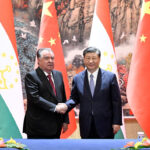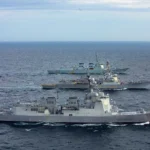CentralAsia (CA) – Military history suggests that the current Ukrainian campaign is much more complex than the public thinks, writes Foreign Policy.
The stated policy of the Ukrainian government is to reclaim all territory captured by Russia since 2014, including Crimea. To achieve this goal by military action, the Ukrainian military must solve one of the most difficult military tasks: they must break through dense, well-prepared defensive positions, find a passage, and then either quickly advance to an important geographical target, such as the Sea of Azov, hoping to unravel along the way the remnants of the defending Russian army, or to quickly try to encircle part of the sizable Russian forces in the hope of destroying them.
Failure in such a campaign would mean that Ukraine is likely destined for a long war of attrition—an unfavorable war that pits it against a much more populous country. Ukraine naturally wants to avoid a war of attrition by succeeding in its breakthrough campaign. But military history suggests that the problems here are more serious than is commonly believed – at least among the population in the West.
The breakthrough problem arose during World War I, when European nations first became rich and populous enough to defend very long fronts—in some cases, almost their entire frontier. They were helped in this by significant improvements in firepower, including range, rate of fire, accuracy and lethality, which increased the typical advantage of the defenders: the ability to choose the terrain on which they will fight, build fortifications and organize their forces in ways that allow the most effective use of firepower, for example, setting up ambushes.
The sophistication of tanks, fighters, and radio communications enabled experienced attackers to break through defenses early in World War II, but over time, defenders found ways to use the same means. The mobility of armored forces allows the defender to quickly transfer reserves to those segments of his defense that seem to be the most vulnerable. With reasonable air defense, lateral movement of armored vehicles behind their lines is much easier than moving armored vehicles forward against a defended position. Defense added to its repertoire of techniques the massive use of anti-tank and anti-personnel landmines, which US analysts concluded shortly after World War II were very cost-effective as anti-tank weapons, accounting for as much as 20% of all tanks.
Although cinematic depictions of World War II seem to portray a more dynamic battlefield than World War I, both wars degenerated into brutal and bloody battles of attrition. As in the First World War, soldiers from all sides groped for ways to break through the defenses, restore mobility, and maneuver on the battlefield. Ultimately, they found ways to do so, though only after much hard-fought fighting and usually only after they had amassed vast material superiority. A military rule of thumb has emerged that a combat power advantage of at least 3 to 1 is necessary to have a reasonable chance of success against a well thought out defense.
But the attackers must do much more than simply organize material superiority. The defender must be weakened in front so that he loses cohesion after some initial fight; his tactical reserves can be weakened by preliminary actions, delayed during combat, or simply overwhelmed as they appear; and its operational reserves must also be either weakened in advance, or diverted to other tasks by deception or supporting attacks, or also destroyed as they arise. All these tasks need to be integrated and synchronized, which is important for any army.
At the time of this writing, it is possible (to the best of the available data) to observe Ukraine’s efforts to address some of these problems – mainly the problem of the initial breakthrough. As everyone now knows, the Russians have prepared a dense and well-built defensive system. Minefields, deep anti-tank ditches and concrete obstacles slow down the attacker. Buried defenders, some in earthen ramparts, others in concrete bunkers, cover these obstacles with direct fire from machine guns and anti-tank missiles. They are probably supplemented by tanks and armored personnel carriers firing from their entrenched positions. Defensive defense combat vehicles often move between several prepared positions to avoid enemy fire suppression. Artillery fire from the rear makes it possible to suddenly focus on the attacker a large number of shells and missiles, sometimes cluster munitions. The attacker must clear minefields and remove other obstacles while under targeted fire. At the same time, he often stops, so the defender’s fire is very effective. The attacker may have to move despite the presence of mines, and thus the mines take their share.
We have also seen Russian attack helicopters function as highly mobile tactical reserves. When a Ukrainian unit hangs on a fence or minefield, rockets from a helicopter reinforce local Russian defenders. Due to the low-altitude tactics that Russian pilots are likely to use and the range of their anti-tank weapons, these helicopters are very difficult to hit with ground-based air defenses.
Thus, obstacles and fire work together to slow down and ultimately destroy attackers. Battle reports show that the best Western armored vehicles in these battles – Leopard II tanks and Bradley fighting vehicles – received significant damage in their attempts to attack. The only positive for Ukraine is that crews and infantry squads tend to survive damage to equipment, which is a tribute to Western designers. But this is not enough for the success of the offensive. For a successful breakthrough, the vehicles themselves need to be able to move forward, drawing their firepower into the depths of enemy positions.
Historically, defenders have been weakened by two measures. The simplest is their preliminary exhaustion, supplemented by an immediate shock from a powerful offensive combat operation. The attacking force simply fights the defending force for a long time, at great expense, and bets that the defense will not be able to make up for its losses as quickly as the attacking side can.
This is what the Allies did during World War II when they fought the Germans. Over time, German combat power simply dwindled, mainly in the fighting at the front, but also as a result of the Allied bombing. The US, Soviet Union, and Great Britain, vastly superior in combined population and industrial power, produced many more weapons and fielded far more units than the Nazis. All efforts by the German army to maintain a coherent defense backed up by mobile reserves simply failed due to lack of sufficient resources, although the tactical savvy of the Allies took a long time to catch up with the Wehrmacht.
Complete destruction was also an important tool for the Allies to finally thin out the defenses. As breakthrough efforts were made in the West, the US and UK combined massive artillery fire with concentrated bombing strikes. The Soviets in the east did the same, although they relied more on their artillery than on their aircraft.
It does not seem that the Ukrainian artillery, rocket launchers and drones complex has quite coped with this task, but only the unfolding campaign can provide an answer to this question. And while Ukraine hopes the West will soon supply it with fighter jets, the US experience in Operation Desert Storm against a much less capable adversary than Russia suggests that the numbers needed to both suppress Russian air defenses and strike Russian ground forces in depth far exceeds any figure proposed so far.
Another way to loosen the enemy’s strength on the ground is to take him by surprise on a sector of the front which, for his own reasons, he left lightly defended. This is what the Germans did against the Americans in the Ardennes forest in December 1944 in the Battle of the Bulge. The United States and Britain did not have sufficient forces to conduct an offensive along the entire front. The United States used the hilly and wooded terrain of the Ardennes, which was considered more fortified, to achieve an “economy of force”. Not only did they cover the front with a density equal to half that recommended by their own doctrine, but they also used the Ardennes as what historian Charles B. MacDonald later called a “nursery and retirement home”, breaking up green units new to the theater of war. and providing space for veteran divisions, who suffered from unusually severe exhaustion, to restore their strength. German intelligence realized this, and careful camouflage and deception allowed the Germans to concentrate very large forces in this sector without US detection, achieving a favorable overall balance of power, perhaps 3 to 1. The Germans had some initial success, but their failure to defeat Allied tactical and operational reserves and to fully resupply their forward units eventually forced them to stop the attack.
The Ukrainians, in their successful offensive in the Kharkiv region in the fall of 2022, discovered a poorly controlled sector of the front. At the beginning of the year, the Russians had suffered enough losses, and they needed to save somewhere, which they did in Kharkov. Ukrainian intelligence understood this and either managed to surprise the Russians, or the Russians simply decided to accept the loss. Although their withdrawal looked like a flight, they avoided the capture or destruction of most of their units.
The Ukrainians, no doubt, hoped to repeat the Kharkiv experience in their counteroffensive in the summer of 2023, but at the time of this writing, success is still out of reach.
At first glance, Russian forces in Ukraine do appear to be weak, which raises hopes for a successful offensive. According to the author’s calculations, the Russians started the war with about 40 brigades. Some of them were defeated and most severely depleted, but the mobilization of Russian reserve troops in the fall of 2022 appears to have allowed them to regain their combat strength. But even if we assume they are at full strength again, at best the Russians can defend the entire 1,000 kilometers (over 600 miles) or so of a front using every brigade without reserves – and even that can be a stretch. During the Cold War, analysts would say that 15–20 km (about 9–12 miles) was the maximum a brigade could successfully defend, even for a short time. But modern technologies, including drones, advanced artillery and ground missile systems, as well as long-range anti-tank guided missiles, allow defensive units to perform larger tasks than their predecessors. The offensive success of the Ukrainian army in the fall of 2022 also, paradoxically, allowed the Russians to reduce their positions and thus make the defensive task easier. The destruction of the Kakhovka Dam in southern Ukraine made it easier to defend the south, further strengthening Russia’s combat power. facilitate the defensive task. The destruction of the Kakhovka Dam in southern Ukraine made it easier to defend the south, further strengthening Russia’s combat power. facilitate the defensive task. The destruction of the Kakhovka Dam in southern Ukraine made it easier to defend the south, further strengthening Russia’s combat power.
The Russians may also have added additional combat units to their forces in Ukraine. In April, General Commander-in-Chief of the US Allied Forces in Europe, Christopher Cavoli, ominously declared that Russian forces in Ukraine are stronger than at the beginning of the war. He did not give figures, but I heard figures of up to 300,000 soldiers compared to 200,000 at the beginning of the war. If this is true, then Russia has likely deployed additional brigades to Ukraine, boosting Russia’s ability to maintain tactical and operational reserves.
Some Western experts suggest that the Russians are stripped of reserves, but that would mean the Russians are still in the military amnesia they were at the beginning of the campaign. However, the Russians have been fighting effectively for several months now, so they must have remembered something from their old manuals and practices, and they also managed to use new technologies. If Western and Ukrainian intelligence believe that Russia does not have significant reserves, this explains both Ukraine’s determination to continue its efforts to break through Russian defensive positions and the Western military’s assertions of confidence in the offensive. They can still hope to eventually breach Russia’s first line of defense, restore mobility on the battlefield, and disable the remaining Russian forces. However, if this assumption is incorrect, then it does not make sense for Ukraine to continue the current counteroffensive attempts, because even if it penetrates deep into the territories occupied by Russia, the Armed Forces of Ukraine are likely to be met with serious counterattacks. At the same time, Kyiv will find itself in the worst circumstances for it: with forces weakened by exhaustion, stretched and dispersed as a result of previous battles and, probably, insufficiently supported technically. Who knows, at this point, Ukrainian forces could be out of range of their drones, artillery, and missiles they used to rely on, now rendered ineffective by Russian interference. At the same time, Kyiv will find itself in the worst circumstances for it: with forces weakened by exhaustion, stretched and dispersed as a result of previous battles and, probably, insufficiently provided technically. Who knows, at this point, Ukrainian forces could be out of range of their drones, artillery, and missiles they used to rely on, now rendered ineffective by Russian interference. At the same time, Kyiv will find itself in the worst circumstances for it: with forces weakened by exhaustion, stretched and dispersed as a result of previous battles and, probably, insufficiently provided technically. Who knows, at this point, Ukrainian forces could be out of range of their drones, artillery, and missiles they used to rely on, now rendered ineffective by Russian interference.
Such a terrible outcome is not guaranteed, but the problem for Ukraine is that it has no experience to draw on if such a negative situation does develop. And since the Ukrainian air force is small and mainly designed for defense, the air force will not be able to save the Ukrainians. They will be left to themselves. Although the Russians did not at first show great skill in mobile operations and a great capacity for improvisation, they greatly improved their tactics during the course of this conflict, and it is possible that they are waiting for their moment.
The Ukrainians are still at the start of their summer offensive. At the time of this writing, they were advancing in what appears to be one major offensive targeting the Sea of Azov and a secondary offensive around Bakhmut. If these efforts begin to gain momentum, they still have to face two major challenges: Russian tactical reserves deployed in their path to break their momentum, and Russian operational reserves that could muster for counterattacks on the expanding Ukrainian flanks. Russian aircraft, which have been much more successful in ground attacks in recent weeks than they were at the start of the war, could further slow Ukraine’s advance by hitting both units and logistics.
It is likely that these problems were analyzed during military exercises with NATO advisers, and solutions, at least in theory, were found. But history shows that these are very demanding operations in terms of technology, planning and military skill. There are few facts sufficient to make an informed guess about Ukraine’s chances of success. But observers should not be surprised if this offensive ends in partial success at best.
Source : Central Asia
















